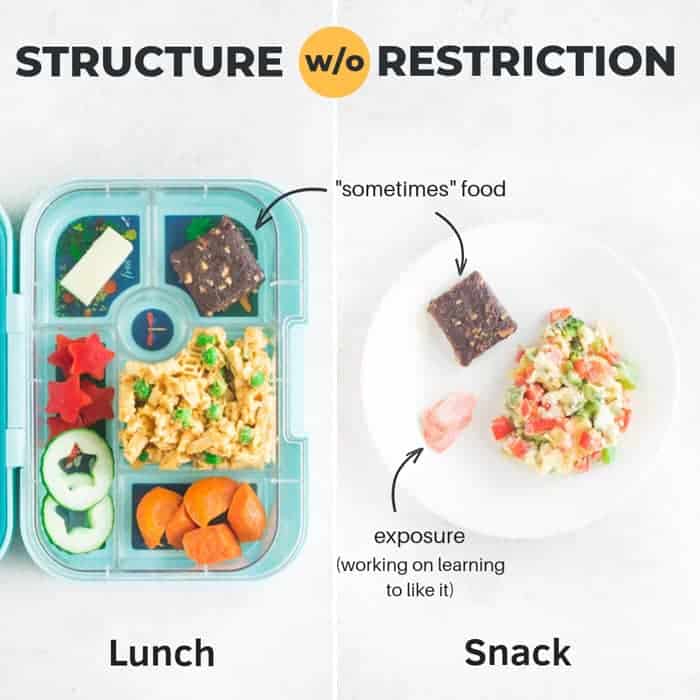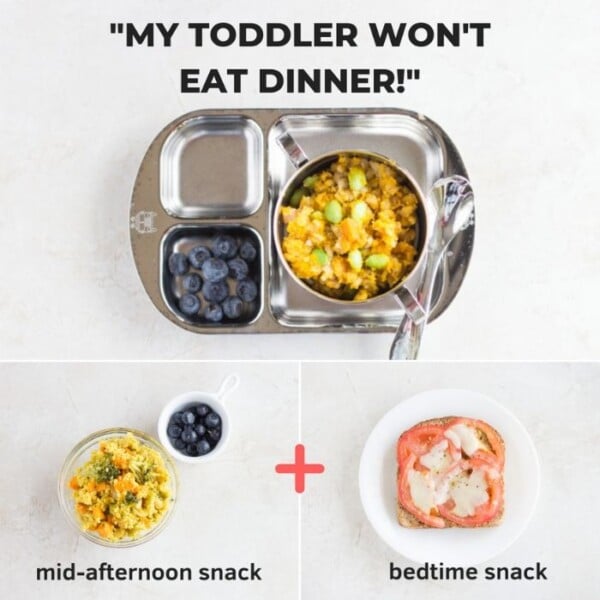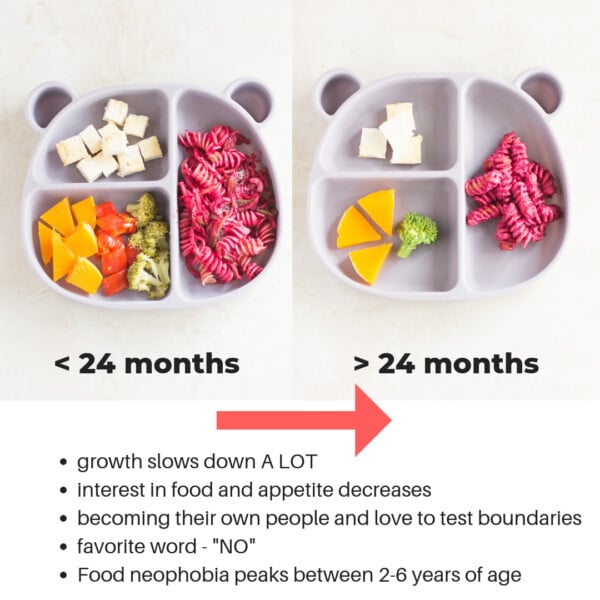This post may contain affiliate links. Please see our disclosure policy for more details.
Is your toddler or older child obsessing and eating too much sugar? Learn how to manage sweets and help promote balanced eating and a healthy relationship with food.

There are sugary treats all around us. While it’s easier to keep them away from our children when they’re younger, sooner or later they’re going to be exposed to them. And most likely, they’re going to love them because let’s face it, they’re delicious.
But if we go deeper, research shows us that not only do they have a stronger preference for sugar than adults, their attraction to sweets is hard-wired.
So how can we help our children to navigate this sugar-filled world all the while helping them to develop a healthy relationship with food? I hope reading this post will give you the knowledge and confidence to accomplish just that!
This is going to be a lengthy post but please stay with me here. The overall message that I want to impart is that ALL food has a place in our children’s diet.
While we can’t control our child’s eating, we can certainly set structure and boundaries and help them to develop healthy eating habits as they grow.
When to introduce added sugar?
Try to wait for as long as possible! The current recommendation is to wait until at least 2 years of age. Read my previous post on why this is important.
Now, I know it’s nearly impossible to stay 100% clear from added sugars since they’re in so many foods, like breads, cereals, pasta sauces, etc. So for the purpose of this post, I’m focusing on the typical sweet foods – like cookies, brownies, cakes, ice cream, etc.
You might’ve found this to be true with your child (or even yourself). The more sweets they get, the more they’ll like and crave them. This applies to all highly palatable foods, like sugar, salt, and fat.
What happens when these foods enter our bloodstream? Not only do they disrupt appetite regulation, but they also induce the brain’s pleasure and reward centers.
Once children experience pleasure from eating these foods, they’re more likely to want to eat them again and again…and again.
All this to say, if they’re not really aware of them and aren’t showing much interest, there’s no reason to go out of the way to introduce them.
Use their ignorance to your advantage and enjoy this time because it’s not going to stay this way for long. Now, if you feel strongly about enjoying a birthday smash cake together, then
What to do when your child becomes aware of the sweets?
Realistically, as the child grows, there’s no way you can avoid added sugars altogether, and neither should you! While it’s easier to control what our kids are exposed to when they’re younger, as they grow and enter the real world, it starts to become a real challenge.
The key here is BALANCE and MODERATION.
What NOT to do
- Use sweets as a reward. This can interrupt the child’s ability to self-regulate and can increase emotional overeating. Rather than giving them candy for potty training progress, good behavior, etc., think of fun ways to reinforce good behaviors like adding stickers to a chart, putting marbles in a jar, etc.
- Be the sugar police. When kids feel deprived, they may compensate by sneaking food, throwing tantrums, and exhibiting other undesirable behavior.
- Label food as “good” or “bad,” around your child. This is the exact opposite of what we’re trying to do, which is to guard them against all the food rules and to teach them that they have permission to eat ALL foods. There shouldn’t be feelings of guilt, shame, or pride when it comes to food and eating.
If you have/had struggled to make peace with food and your body like me, I know you’d do anything to protect your child from all of those detrimental emotions.
What to do:
TRUST. We need to TRUST our child’s ability to eat and regulate based on what their bodies need. We need to TRUST them around sweets. And if you’re a control freak like me, this just may be a nearly impossible thing to wrap your head around.
But this doesn’t mean we just sit back and hope for the best.
Yes, babies are born with an innate ability to self-regulate. However, they don’t know how to choose a well-balanced diet. What they need help with is learning how to balance all foods in the diet, the healthy and not so healthy.
And in order for them to learn this important skill, they need to be given plenty of opportunities to do so.
To put this into practice, I want to remind you of the division of responsibility in feeding. We, as parents, help them navigate the vast sea of food choices by providing structure, opportunity, and loving support.
We are in charge of what, when, and where a child is fed. And our children get to be in charge of what foods they want to eat out of those given choices, how much, and whether or not they’ll eat.
In other words, as gatekeepers of the family’s food supply and someone who cares deeply for the well-being of their children, let’s set consistent and predictable mealtime structure and boundaries while encouraging our children to do their job with eating.
For specific tips on how to help your child to develop a positive, healthy relationship with food, check out this post.
How to Balance Sweets?

Implement a sweet policy
Ask yourself, are you overly restricting sugar or has it become a free for all in your household?
Sweets are going to be around for a long time. Therefore, we NEED to balance sweets with healthy eating. That way they’re getting the foods they need to grow and thrive AND their cravings and desires for certain foods are satisfied.
So plan for sweets at home.
You get to decide what and when dessert will be eaten. How often and how you want to handle sweets will look different for every family. It’s a personal decision so there’s no need to compare with what other moms are doing.
My biggest advice is to always follow your heart and do what you feel is best for your family. Are you ok with allowing one treat per day? Only on the weekends? 2-3 times a week? You get to decide.
If your child is old enough, perhaps get your child involved in the decision making! They thrive on structure and predictability so use that to your advantage!
Having a sweet policy also makes it easier for you to say no and explain exactly when your child can enjoy them next time. For instance, if you’ve decided to enjoy sweets together on the weekends only, you can say something like, “how about we save that and enjoy it on Saturday?”
And make sure you follow through! This is an example of loving with limits.
Two Specific Strategies
Here’s what the child feeding expert and a fellow registered dietitian, Ellyn Satter suggests. She truly is the authority on how to make feeding practical, positive, and joyful for parents and their children. Keep in mind, these apply to older children.
If your toddler isn’t really aware of the sweets around them or isn’t all that interested, there’s no need to go out of your way to incorporate them into your mealtime structure just yet.
1. Serve a small portion of sweet treats WITH the meal. What this does is neutralize the power of sweets and keeps mealtimes a neutral playing ground. You child may eat it first, or it might be the only thing that they eat. But by doing so, you’re teaching them that all foods can have a place in a healthy meal.
Your child will most likely to eat dessert first for awhile, but it won’t be like that forever. They will eventually learn to enjoy the meal as a whole without obsessing about certain foods.
Your child may take a bite of a cookie and then beef and broccoli. Then another bite of cookie. I think that’s pretty awesome! Stay consistent with your structure. I can’t emphasize this enough!
Important to note: Don’t offer seconds. Your child can choose what foods they want to eat and in what order. And while you can certainly offer more of whatever food was on the plate (don’t offer something that wasn’t initially served – you can read the reasoning behind it in this post – Help! My toddler won’t eat), dessert is limited to one portion.
2. Offer sweets once a week during snack time and allow your child to eat as much as they want. For instance, put out a plate of cookies or cakes on the table and let your child have at it. Sure, they may overeat. They may not!
But the idea behind it is that it will take the newness out and they’ll stop obsessing about them. When they learn that they have full permission to eat their “special” foods and see an abundance, that’s when
Again, I want to emphasize the two words I’ve been mentioning throughout this post – BALANCE and TRUST.
Eating a lot of cake and bingeing every now and then won’t harm their health. There’s actually an important lesson to be learned there. Your child may feel so uncomfortable afterward and may choose differently next time the opportunity arises.
And remember, if your sweet policy is not working, don’t be afraid to change it. Oftentimes it helps to involve your older children in the decision making.
Our current strategy
My son is now 4 years old and we do sweets and other “fun” foods 2-3 times a week during lunchtime. This is helpful because he will be going to preschool three times a week and I can incorporate them into his lunchboxes. He won’t feel so left out when he sees his friends enjoying theirs.
The first time we tried the second strategy was when C was 3.5. I presented him with a plate full of animal crackers, his favorite at the time, alongside a glass of milk and apple + peanut butter, and told him he could eat as much as he wanted. To my surprise, he ate about 10 pieces and said he was done.
Therefore, I use this strategy when it appears that he’s especially fixated on a particular food.
Grandparents
I do want to mention briefly about how to handle situations when your parents or in-laws are constantly “spoiling” them with treats. If your parents are anything like mine, food is definitely their love language.
If your child spends time with the grandparents occasionally, I say just leave it. Perhaps this will be the day you implement the second strategy mentioned above. Think of it as a great opportunity for your child to learn about balance and know that too many sweets on one particular day won’t harm them.
On the other hand, if grandparents are the regular sitters, start by having an honest and open discussion about your feeding philosophy and routine.
What’s most important is that you always approach them from a place of love and respect. That way, they won’t feel like they’re being attacked or unappreciated.
You can share current research and provide them with simple, clear instructions. Another great way is to compromise and meet each other in the middle. For instance, instead of telling them to not give any cookies, ask them to serve just one cookie WITH the meal.
In the end, what’s most important is that you support and value the relationship between your children and their grandparents! And don’t be shy in letting them know how grateful you are for all that they do! This is a great reminder for me too!
To Sum
We, as parents, can absolutely help our children develop neutral associations with the ever-so-prevalent sweets so that they don’t grow up feeling obsessed or guilty of the food choices that they make.
Food is meant to be celebrated and enjoyed. Let’s teach them to TRUST their bodies and to value all foods. BALANCE and MODERATION is achievable!
I’d love to know! How are you striking a balance with sweets in your household currently?”
BTW, if you want the recipe to those scrumptious brownies you see in the first image at the top, here it is – Zesty Orange Fudge Brownies. I kinda heart them ;).
















is it okay or not to teach them about sugar and what it does to our bodies? or does it make it seem more “prohibited” and tempting?